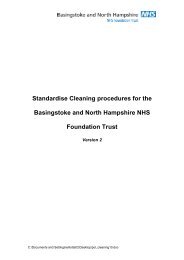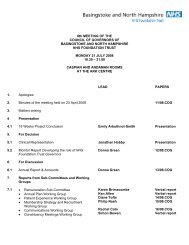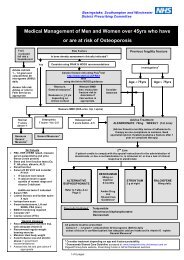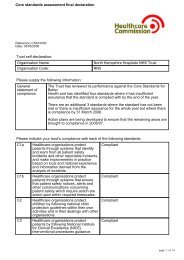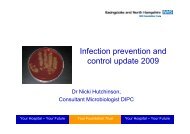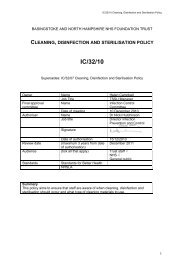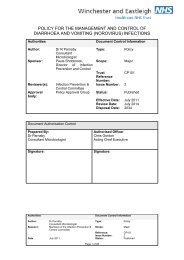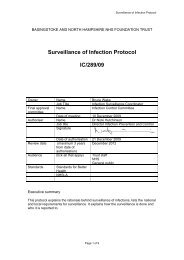Isolation and infectious diseases policy - Hampshire Hospitals NHS ...
Isolation and infectious diseases policy - Hampshire Hospitals NHS ...
Isolation and infectious diseases policy - Hampshire Hospitals NHS ...
Create successful ePaper yourself
Turn your PDF publications into a flip-book with our unique Google optimized e-Paper software.
Winchester & Eastleigh Healthcare <strong>NHS</strong> Trust<br />
Policy for <strong>Isolation</strong> <strong>and</strong> Infectious Diseases Policy<br />
bottle labelled ‘Danger of Infection’ <strong>and</strong> placed in separate sections. The first<br />
specimen bag should then be resealed within another, i.e. double bagged.<br />
The laboratory will follow st<strong>and</strong>ard operating procedures to ensure the<br />
specimen is h<strong>and</strong>led <strong>and</strong> processed correctly.<br />
9 PRACTICE AND RATIONALE<br />
Isolated patients may experience more anxiety <strong>and</strong> depression. <strong>Isolation</strong> may<br />
hamper rehabilitation. To reduce these risks, preparatory information should<br />
be given wherever possible. When a patient requires isolation staff should<br />
ensure effective communication for patients, staff <strong>and</strong> visitors.<br />
Explain to the patient if possible<br />
the reason for isolation,<br />
explanation of the nature of disease or organism,<br />
symptoms <strong>and</strong> treatment – a leaflet maybe helpful,<br />
control methods <strong>and</strong> their rationale<br />
advice for patients regarding their responsibility <strong>and</strong> their<br />
adoption of correct measures<br />
give reassurance to reduce patient’s anxiety.<br />
9.1 APRONS/GOWNS<br />
9.1.0 Plastic aprons afford more protection to uniforms/clothes than gowns because<br />
they are water repellent <strong>and</strong> impervious to microbial contamination. Yellow<br />
plastic aprons should be worn when in contact with the patient, the immediate<br />
environment, body substances <strong>and</strong> when h<strong>and</strong>ling laundry/making the bed.<br />
Aprons are single use items <strong>and</strong> should be discarded after each use <strong>and</strong><br />
before leaving the room, with the exception of moving bedpans <strong>and</strong><br />
commodes to the sluice.<br />
9.1.1 Put on a yellow plastic apron before entering the room. Remove it in the room<br />
<strong>and</strong> place in the yellow clinical waste bag before leaving the room.<br />
9.1.2 Non- sterile disposable gowns are required for caring for patients with scabies<br />
<strong>and</strong> when recommended by the IPCT.<br />
9.2 GLOVES<br />
Gloves are worn to provide a protective barrier <strong>and</strong> to prevent cross<br />
contamination of the h<strong>and</strong>s when touching blood, body fluids, secretions,<br />
12<br />
Authorities<br />
Document Control Information<br />
Author:<br />
Sponsor:<br />
Date:<br />
Dr Kordo Saeed<br />
microbiologist<br />
Sue Dailly Lead Nurse<br />
Infection Prevention <strong>and</strong><br />
Control<br />
Paula Shobbrook Director of<br />
Infection Prevention <strong>and</strong><br />
Control<br />
01/08/11<br />
Type:<br />
Scope:<br />
Reference:<br />
Issue No:<br />
Status:<br />
Policy<br />
Major<br />
CP022 (IC 04)<br />
4<br />
Published



